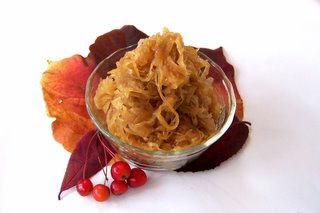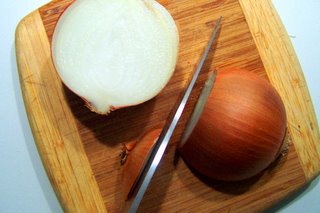 When food is cooked slowly, it not only evenly browns, it naturally becomes sweeter, richer and more complex. The introduction of heat, as a kiss rather than a bang, will change a sharp taste to something mellow and meltingly accommodating. Suddenly your basic ingredient is open to a whole assortment of additional flavors and uses. We have seen this happen like culinary stardust with prior Kitchen Project posts - like those on roasting garlic and blistered peppers. It is a wonderment indeed.
When food is cooked slowly, it not only evenly browns, it naturally becomes sweeter, richer and more complex. The introduction of heat, as a kiss rather than a bang, will change a sharp taste to something mellow and meltingly accommodating. Suddenly your basic ingredient is open to a whole assortment of additional flavors and uses. We have seen this happen like culinary stardust with prior Kitchen Project posts - like those on roasting garlic and blistered peppers. It is a wonderment indeed.So here now, for your reading pleasure, I am going to once again offer up a recipe of sorts, though maybe I should call it a technique. Which ever way, it is indeed a Kitchen Project, (Part of my series on things to do when you want to spend time in the kitchen) and this time up, it's that culinary darling, caramelized onions. Everything you could ask for in a recipe, extreme simplicity resulting in a sublime flavor.
The standard, brown, storage onion, as we all know, is readily available year round pretty much everywhere, and is cheap as chips. It is a member of the lily family, and heaven knows it can make you weep like a small child when you go at it with a knife. Despite a host of folk remedies, the only tried and true method I have ever happened across that fixes the tears is to keep doing it. The more onions you chop, the less likely you are to cry. (Shrug) There is also some relief to be had if you chill the onions first...or so I hear.
Like that first time you steamed a huge bunch of fresh spinach and ended up with about a teaspoons worth of jewel-toned wilted leaves, you will be amazed at how a huge quantity of silvery slivers will end up a scant offering after awhile on the stove. That is the main reason I do this in huge batches. So when you have the time and have committed to doing this, just remember, it's going to take pretty much the same amount of time to cook down twenty onions as three. While three seems like a nice do-able number, I strongly suggest you just go for the gusto and make a mad huge batch. Besides, there is no reason to bother with just one onion when the resulting product freezes perfectly.
That said, on with the show.
You are going to need:
Onions
Butter
And maybe some sugar
For tools, you should have:
A good sharp knife and some dedication OR a slicer. I got mine in Chinatown for $14. Remember, in Chinatown you can negotiate better prices with most vendors. Don't be shy. (I have to say, I also have a fancy pants mandoline that is huge and cumbersome, impressive and shiny, and hardly ever sees the light of day. My smaller one is feather light, dishwasher safe and gets pulled out almost daily. Food for thought indeed.)
 To begin, cut your onions in half through the root end. Do this with all of them first. My theory on cooking is that if you only do each step once (peel all, mince all, whatever) it streamlines the process. Next up, slice the tiniest bit of the tip/top off of all of the onion halves. Then peel off the skins (of all.) and starting at the tip end, slice the onions into the thinnest possible half moons.
To begin, cut your onions in half through the root end. Do this with all of them first. My theory on cooking is that if you only do each step once (peel all, mince all, whatever) it streamlines the process. Next up, slice the tiniest bit of the tip/top off of all of the onion halves. Then peel off the skins (of all.) and starting at the tip end, slice the onions into the thinnest possible half moons.In a large pan melt 1/2 teaspoon of unsalted butter per 4 onions, over low heat.
Add the onions to the pan and do your best to stir them so they are all coated with some of the melted butter. Its ok if the pan is full to the brim, they cook down.
And here, you turn the flame to low, and stir every four to six minutes for a good long time. The onions in the picture took just under three hours. If at any point you sense the onions are in need of some more butter, (read: they are getting crispy) don't be shy about throwing in another pat.
If you want to cheat (and I'm not advocating that so much as just letting you know it can be done) sprinkle some sugar over the entire batch about 10 minutes into cooking. The sugar will brown quickly, so while you will get the color and sweetness, your onions will not really have released so much liquid and will still be relatively crunchy. With the long form method, you are going to end up with nutty sweetness and soft onions; with the addition of sugar it will have a more pronounced sugar sweetness and less of the natural carmelized taste.
Sometimes for giggles, I add some minced rosemary or sage in towards the end of cooking, but thats just guilding the lily (hardee har).
Now what do you suppose you do with this glorious batch? The classics are French Onion Soup and Pissaldiere. From there, I challenge you to come up with your own uses.
__________________________________
Vidalia® onions are sweet onions grown exclusively in a 20-county region in Georgia
The name onion stems from the Latin word unus meaning oneness or unit
Libyans consume approx. 66.8 pounds of onions person/year. The worlds highest per person consumption. North Americans average 19 - Onions-USA.org
Why not be a sport and check out Kate's post on the 2005 Food Blog Awards...she is taking nominations until Midnight tonight. (Totally un-subtle cough, cough, wink, wink, hint)
Rachael-I just tagged you for a meme!
ReplyDeleteThanks Ilva, it should be fun, although, I'm not sure when I'll get to it, so keep checking back...
ReplyDeleteHappy Holidays!
I tried caramelizing onions yesterday for dinner! Mmmm....well, I didn't do it for a very long time but they cane out decent. I wondered why I could never caramelize them before and it was because I...um...was practically steaming them before. Mmm = steamed onions? NO.
ReplyDeleteAnyway, caramelized onions are one of the yummiest foods ever.
Hi Rachael. I just found your blog while searching for comments about caramelizing onions. Love your style. I want to share a terrific BBQ sauce that I make with caramelized onions. I call it “South Carolina Style BBQ Sauce” because it features mustard. To 1 cup of white cider vinegar add 2 Tbs. of Tabasco, 3 Tbs. lemon juice, 1 Tbs. dry mustard, 1 tsp. salt, 1/2 tsp. black pepper, 1/3 cup of sugar (or Splenda) 2 small bay leaves, and 1 rounded tsp. garlic powder. Let this steep for awhile, then stir and pour over 2 cups caramelized onions. Slowly simmer this for 90 minutes in an uncovered heavy pot. Add 1/2 cup boiling water when necessary to keep liquid at 1 cup level. Strain sauce through a fine colander and add boiling water through the colander to make 1-1/2 cups total. Pour this hot into about 3 lbs. of any version of mildly seasoned pulled pork (also hot). Mix, put all back in same pot and refrigerate overnight. Reheat the resulting pork BBQ in oven pre-heated to 175 degrees. I serve BBQ with a traditional North Carolina vinegar sauce: to 1 cup of cider vinegar add 1 tbs. Tabasco, 1 Tbs. sugar, 1 Tbs crushed red pepper flakes, salt, and black pepper. Let this steep for 10 days and strain out the flakes. If you have questions, email me: stephentyler5 (at) cox.net
ReplyDeletePS: You are free to publish this. Don’t cite me, just use it and make it your own!!!
oops, I left out an important ingredient. In addition to the seasoned vinegar, also pour over the caramelized onions1/2 cup of peanut oil or any type vegetable oil.
ReplyDeleteThat part of the recipe should read like this: “… then stir and pour over 2 cups caramelized onions. Add 1/2 cup of peanut oil. Slowly simmer this for 90 minutes in an uncovered heavy pot.”
I just completed a big batch of caramelized onions per your instructions (6 lbs. of onions!!!)It took about 4 hours, but the end product was awesome. I figure I will have frozen caramelized onions for 6 batches of pork BBQ.
ReplyDeleteI proceeded to make my BBQ sauce and discovered that the recipe requires only ONE cup of these incredibly dark and condensed onions. When I added the seasoned vinegar, the onions puffed right up again.